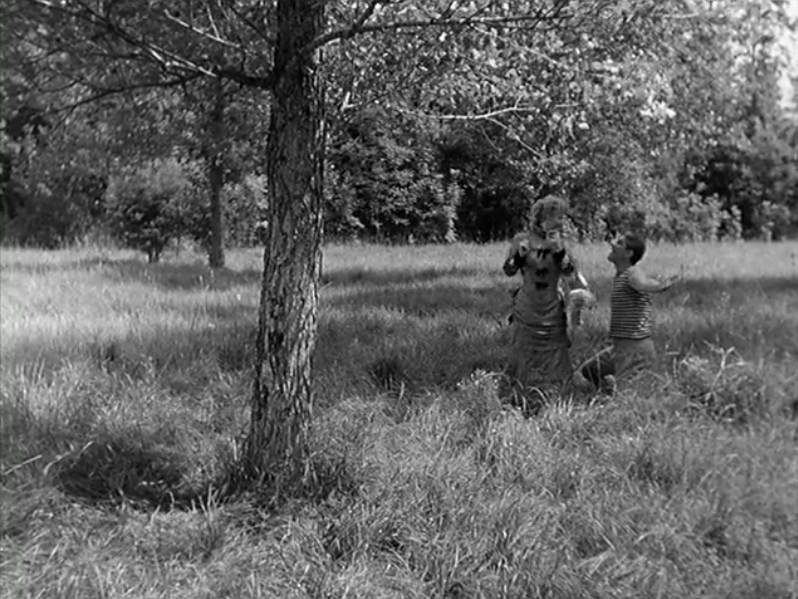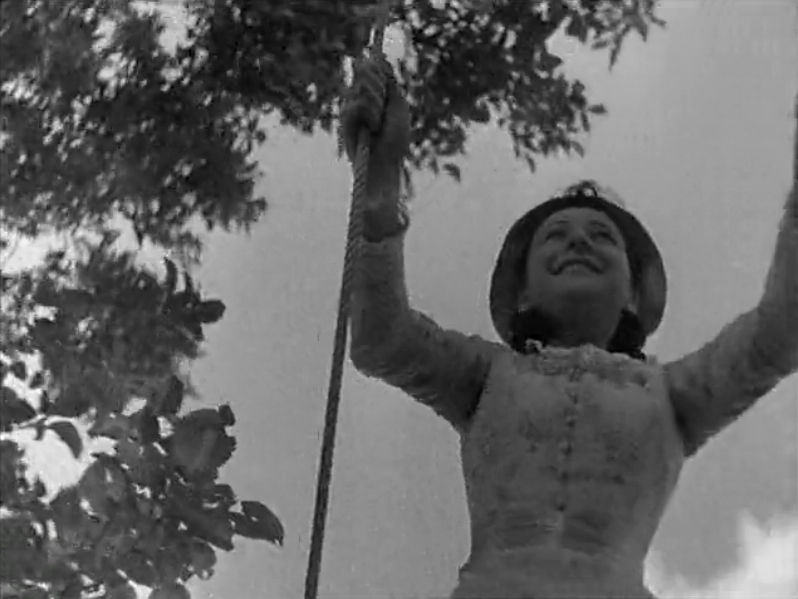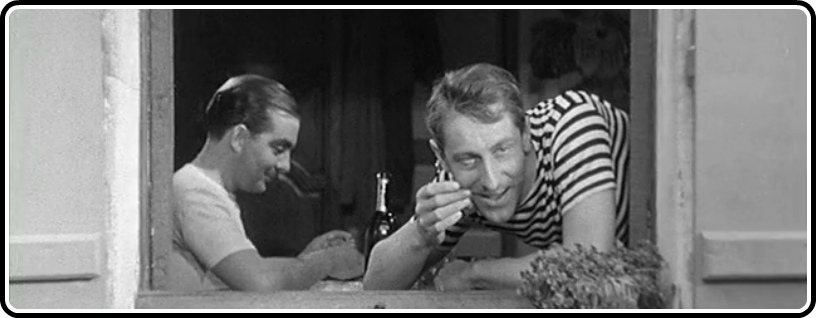Is there anything lovelier than Jean Renoir in the ’30s? Even before he made such unassailable classics as Grand Illusion or The Rules of the Game, Renoir had a knack for capturing the emotional tenor of everyday life, revealing it to be at once more pleasant and tragic than it may otherwise seem. In this pursuit, however, he did not divert from the truth, artistically insisting that the mundane was every bit as engaging and urgent as any high melodrama.
A Day in the Country exists only as an incomplete film. Initiated in 1936, the production was beset by weather problems, and since Renoir soon had to jet off to his next film, he was never able to complete it. It took producer Pierre Braunberger (who had either great affection for the film, or the desire to turn some profit from it) and Renoir’s editor, Marguerite Houllé-Renoir, ten years to reconstruct a workable print of it. Even then they had to resort to title cards to fill in some rather large gaps, the first of which also notes that Renoir was by this time in America, and presumably unable to contribute to the edit.
Still, A Day in the Country is classic Renoir, and we’re lucky to have it. It’s a surprisingly complex piece of cinema for both its time and modest scale, utilizing really only one location but taking advantage of its every inch. Renoir famously worked well in natural environments, contrasting the wild against society in The Rules of the Game and Boudu Saved From Drowning and using it represent freedom in Grand Illusion, but A Day in the Country may be the most he capitalized on it. He uses it to express at once ideality, tranquility, sexuality, and finally isolation. On working in such environments, Renoir stated, “Nature is millions of things. And there are millions of ways of understanding its preoccupations.”

The basic story follows Monsieur Dufour, his wife, their daughter Henriette, and her fiancé Anatole on the titular day, during which they meet Henri and Rodolphe, workers in the country who seem to spend more time plotting pick-up techniques than in any gainful employment. They take to Henriette immediately (and Renoir’s choice to highlight her beauty by putting her on a swing is a graceful, delicate touch, perfectly suiting the film), but upon realizing they can’t share her, begin determining who should occupy the mother’s time.
Unbeknownst to them, the mother is quite good company herself, longing for a “walk in the woods” with her disinterested husband, who’s more than happy to let the women go boating with the strangers after they offer him fishing supplies. Renoir’s creative decision to partner her with the more outgoing Rodolphe makes for some of the film’s more comical outbursts, and allows the more serious-minded Henri time with the similarly-named (and -minded) daughter. Renoir takes different approaches in filming both “couples,” going wide for Rodolphe and Madame Dufour’s scenes (Jacques B. Brunius and Jane Marken are such intrinsically cinematic performers that any other approach is almost unnecessary) and getting in close with Henri and Henriette. The whole affair becomes quite delightful and heartwarming…
Until the inevitable break happens. Unless Renoir was really padding out these early scenes, I’d wager that most of the missing footage would’ve shown what the title cards allude to – the time between this initial encounter and an epilogue one year later – during which the tone shifts drastically. It’s more than a little jarring, and one wonders if Braunberger and Houllé-Renoir might have been better off excising it entirely. This would change the very core of the film, certainly, but given the available elements, it might have made for better drama as well, light on it thought it may be. As it is, it presents a window into what might have been, not unlike the surviving cut of The Magnificent Ambersons or the pre-complete-cut edit of Metropolis. The difference, in terms of artistic integrity, between a truly lost film and an unfinished one is deep, certainly, but all the more reason to refashion this into a short rather than an abridged feature.

But for a film made in 1936, this still stands as a remarkable accomplishment in both its artistry and craft. While Hollywood was still very much learning how to walk in the era of sound, Renoir practically skips through this film. This was only cinematographer Claude Renoir’s second film, but already he demonstrates that his position was not merely a result of nepotism (he was Jean’s nephew). His lush palette, emphasizing the grays and whites of monochrome film stock, creates the carefree air of a day away before the actors have a chance to contribute at all (though, rest assured, they quickly do, and considerably).
Though only a standard-definition presentation, A Day in the Country looks pretty damn good on Criterion’s Hulu channel. It’s nothing you’d want to take home to your mother or anything, but it’s more than enough for a night on the town. It has some compression issues on both the TV and computer streams, but they tend to blend in fairly well with the coarse nature of the source print. Otherwise, it’s grainy and scratchy and everything you’d want a print of a ’30s film to feel like, particularly one in the outdoors, and it seems – to these uninformed eyes (i.e. I’ve never seen the film projected) – very true to the intentions with regards to contrast and so forth. The compression doesn’t even get in the way of detail, usually the first element to go.
I’d be surprised if such a short film got its own Criterion spine, even with Simon of the Desert, a short-ish film as well, having its own spine number. We’re a long way from that in the home video market, and in the age of Blu-ray, Criterion has really stepped up their habit of including whole other features as supplements. The possibilities for which feature to attach this to are numerous, but Boudu Saved From Drowning does have a Blu-ray release overseas, and we wouldn’t mind an upgrade Stateside. And perhaps throw a quick supplement looking at what Renoir might have shot had he the luxury of time.




![Bergman Island (The Criterion Collection) [Blu-ray]](https://criterioncast.com/wp-content/uploads/2022/11/bergman-island-the-criterion-collection-blu-ray-400x496.jpg)
![This Is Not a Burial, It’s a Resurrection (The Criterion Collection) [Blu-ray]](https://criterioncast.com/wp-content/uploads/2022/11/this-is-not-a-burial-its-a-resurrection-the-criterion-collection-blu-ray-400x496.jpg)
![Lars von Trier's Europe Trilogy (The Criterion Collection) [The Element of Crime/Epidemic/Europa] [Blu-ray]](https://criterioncast.com/wp-content/uploads/2022/11/lars-von-triers-europe-trilogy-the-criterion-collection-the-element-of-400x496.jpg)
![Imitation of Life (The Criterion Collection) [Blu-ray]](https://criterioncast.com/wp-content/uploads/2022/11/imitation-of-life-the-criterion-collection-blu-ray-400x496.jpg)
![The Adventures of Baron Munchausen (The Criterion Collection) [4K UHD]](https://criterioncast.com/wp-content/uploads/2022/11/the-adventures-of-baron-munchausen-the-criterion-collection-4k-uhd-400x496.jpg)
![Cooley High [Criterion Collection] [Blu-ray] [1975]](https://criterioncast.com/wp-content/uploads/2022/11/cooley-high-criterion-collection-blu-ray-1975-400x496.jpg)